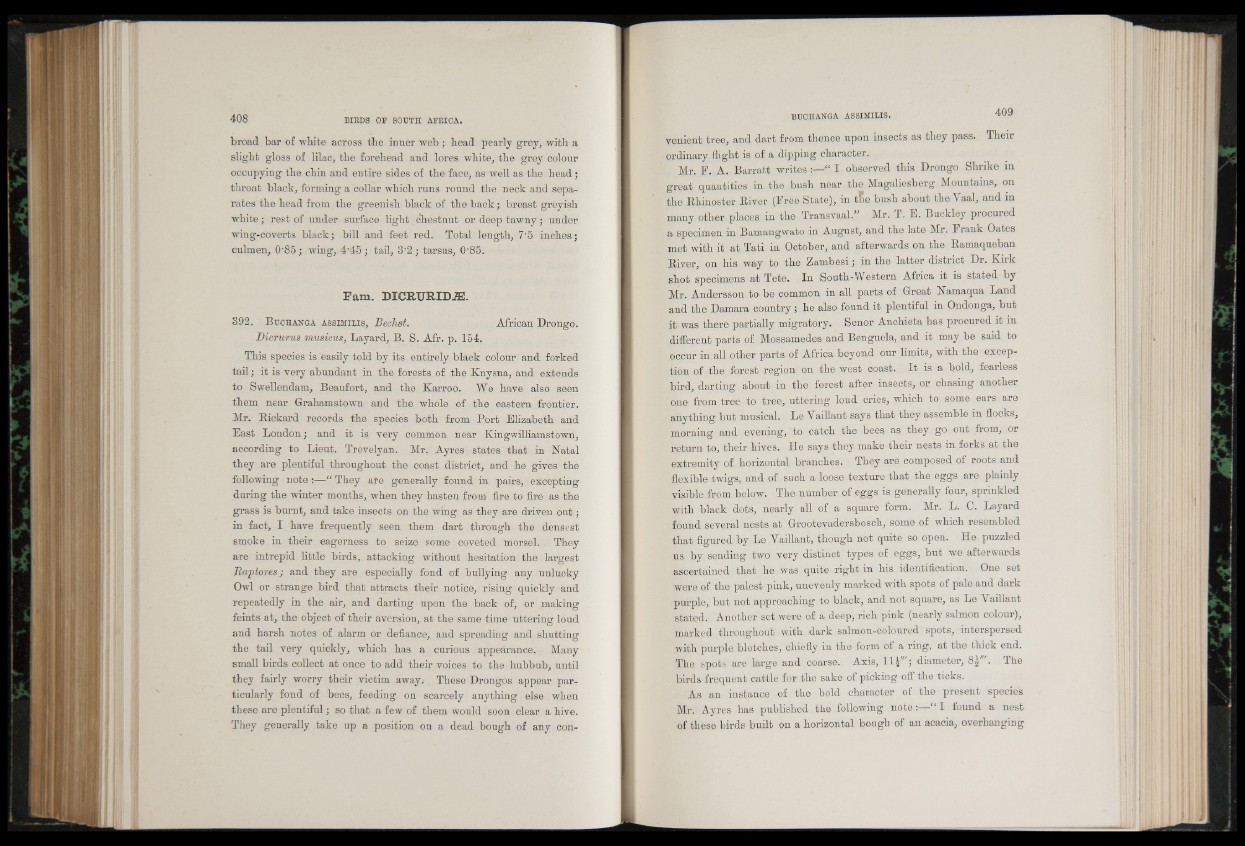
broad bar of white across the inner web ; head pearly grey, with a
slight gloss of lilac, the forehead and lores white, the grey colour
occupying the chin and entire sides of the face, as well as the head;
throat black, forming a collar which runs round the neck and separates
the head from the greenish black of the back; breast greyish
white; rest of under surface light chestnut or deep tawny; under
wing-coverts black; bill and feet red. Total length, 7’5 inches;
culmen, 0‘8o; wing, 4-45 ; tail, 3'2; tarsus, 0-85.
Fam. DICRURIDJE.
392. B u c h a n g a a s s i m i l i s , Sechst. African Drongo.
Dicrurus musicus, Layard, B. S. Afr. p. 154.
This species is easily told by its entirely black colour and forked
tail; it is very abundant in the forests of the Knysna, and extends
to Swellendam, Beaufort, and the Karroo. We have also seen
them near Grahamstown and the whole of the eastern frontier.
Mr. Rickard records the species both from Port Elizabeth and
East London; and it is very common near Kingwilliamstown,
according to Lieut. Trevelyan. Mr. Ayres states that in Natal
they are plentiful throughout the coast district, and he gives the
following note :—“ They afe generally found in pairs, excepting
during the winter months, when they hasten from fire to fire as the
grass is burnt, and take insects on the wing as they are driven out;
in fact, I have frequently seen them dart through the densest
smoke in their eagerness to seize some coveted morsel. They
are intrepid little birds, attacking without hesitation the largest
Rap tores; and they are especially fond of bullying any unlucky
Owl or strange bird that attracts their notice, rising quickly and
repeatedly in the air, and darting upon the back of, or making
feints at, the object of their aversion, at the Same time uttering loud
and harsh notes of alarm or defiance, and spreading and shutting
the tail very quickly, which has a curious appearance. Many
small birds collect at once to add their voices to the hubbub, until
they fairly worry their victim away. These Drongos appear particularly
fond of bees, feeding on scarcely anything else when
these are plentiful; so that a few of them would soon clear a hive.
They generally take up a position on a dead bough of any convenient
tree, and dart from thence upon insects as they pass. Their
ordinary flight is of a dipping character.
Mr. F. A. Barratt writes:—“ I observed this Drongo Shrike in
great quantities in the bush near the Magaliesberg Mountains, on
the Rhinoster River (Free State), in the bush about the Vaal, and in
many other places in the Transvaal.” Mr. T. E. Buckley procured
a specimen in Bamangwato in August, and the late Mr. Frank Oates
met with it at Tati in October, and afterwards on the Ramaqueban
River, on his way to the Zambesi; in the latter district Dr. Kirk
shot specimens at Tete. In South-Western Africa it is stated by
Mr. Andersson to be common in all parts of Great Namaqua Land
and the Damara country; he also found it plentiful in Ondonga, but
it was there partially migratory. Senor Anchieta has procured it in
different parts of Mossamedes and Bengnela, and it may be said to
occur in all other parts of Africa beyond our limits, with the exception
of the forest region on the west coast. It is a bold, fearless
bird, darting about in the forest after insects, or chasing another
one from tree to tree, uttering loud cries, which to some ears are
anything but musical. Le Vaillant says that they assemble in flocks,
morning and evening, to catch the bees as they go out from, or
return to, their hives. He says they make their nests in forks at the
extremity of horizontal branches. They are composed of roots and
flexible twigs, and of such a loose texture that the eggs are plainly
visible from below. The number of eggs is generally four, sprinkled
with black dots, nearly all of a square form. Mr. L. C. Layard
found several nests at Grootevadersbosch, some of which resembled
that figured by Le Vaillant, though not quite so open. He puzzled
us by sending two very distinct types of eggs, but we afterwards
ascertained that he was quite right in his identification. One set
were of the palest pink, unevenly marked with spots of pale and dark
purple, but not approaching to black, and not square, as Le Vaillant
stated. Another set were of a deep, rich pink (nearly salmon colour),
marked throughout with dark salmon-coloured spots, interspersed
with purple blotches, chiefly in the form ol a ring, at the thick end.
The spots are large and coarse. Axis, l l | n ; diameter, 8 J-'". The
birds frequent cattle for the sake of picking off the ticks.
As an instance of the bold character of the present species
Mr. Ayres has published the following note :—“ I found a nest
of these birds built on a horizontal bough of an acacia, overhanging